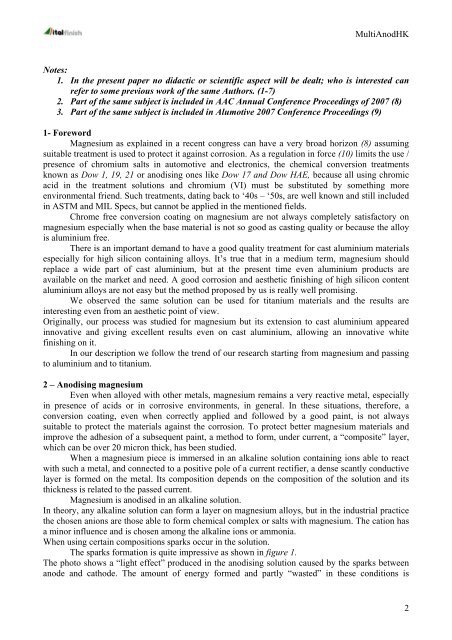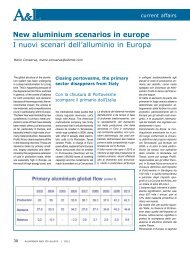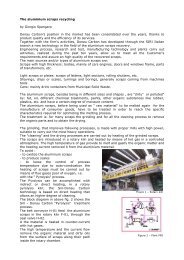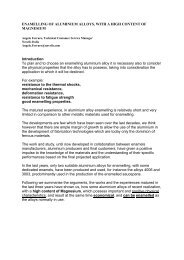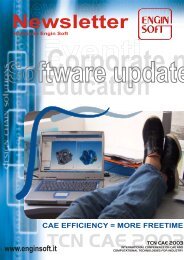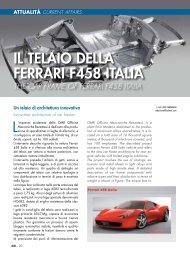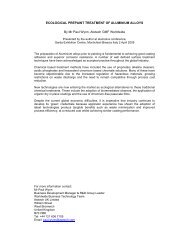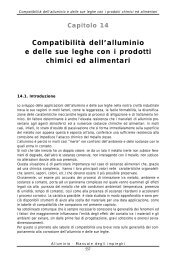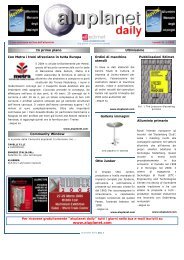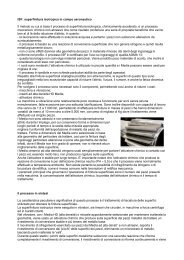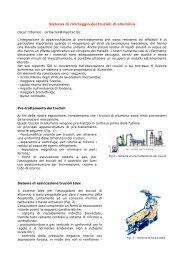A multipurpose anodising plant for non ferrous metals - Aluplanet
A multipurpose anodising plant for non ferrous metals - Aluplanet
A multipurpose anodising plant for non ferrous metals - Aluplanet
Create successful ePaper yourself
Turn your PDF publications into a flip-book with our unique Google optimized e-Paper software.
MultiAnodHK<br />
Notes:<br />
1. In the present paper no didactic or scientific aspect will be dealt; who is interested can<br />
refer to some previous work of the same Authors. (1-7)<br />
2. Part of the same subject is included in AAC Annual Conference Proceedings of 2007 (8)<br />
3. Part of the same subject is included in Alumotive 2007 Conference Proceedings (9)<br />
1- Foreword<br />
Magnesium as explained in a recent congress can have a very broad horizon (8) assuming<br />
suitable treatment is used to protect it against corrosion. As a regulation in <strong>for</strong>ce (10) limits the use /<br />
presence of chromium salts in automotive and electronics, the chemical conversion treatments<br />
known as Dow 1, 19, 21 or <strong>anodising</strong> ones like Dow 17 and Dow HAE, because all using chromic<br />
acid in the treatment solutions and chromium (VI) must be substituted by something more<br />
environmental friend. Such treatments, dating back to ‘40s – ‘50s, are well known and still included<br />
in ASTM and MIL Specs, but cannot be applied in the mentioned fields.<br />
Chrome free conversion coating on magnesium are not always completely satisfactory on<br />
magnesium especially when the base material is not so good as casting quality or because the alloy<br />
is aluminium free.<br />
There is an important demand to have a good quality treatment <strong>for</strong> cast aluminium materials<br />
especially <strong>for</strong> high silicon containing alloys. It’s true that in a medium term, magnesium should<br />
replace a wide part of cast aluminium, but at the present time even aluminium products are<br />
available on the market and need. A good corrosion and aesthetic finishing of high silicon content<br />
aluminium alloys are not easy but the method proposed by us is really well promising.<br />
We observed the same solution can be used <strong>for</strong> titanium materials and the results are<br />
interesting even from an aesthetic point of view.<br />
Originally, our process was studied <strong>for</strong> magnesium but its extension to cast aluminium appeared<br />
innovative and giving excellent results even on cast aluminium, allowing an innovative white<br />
finishing on it.<br />
In our description we follow the trend of our research starting from magnesium and passing<br />
to aluminium and to titanium.<br />
2 – Anodising magnesium<br />
Even when alloyed with other <strong>metals</strong>, magnesium remains a very reactive metal, especially<br />
in presence of acids or in corrosive environments, in general. In these situations, there<strong>for</strong>e, a<br />
conversion coating, even when correctly applied and followed by a good paint, is not always<br />
suitable to protect the materials against the corrosion. To protect better magnesium materials and<br />
improve the adhesion of a subsequent paint, a method to <strong>for</strong>m, under current, a “composite” layer,<br />
which can be over 20 micron thick, has been studied.<br />
When a magnesium piece is immersed in an alkaline solution containing ions able to react<br />
with such a metal, and connected to a positive pole of a current rectifier, a dense scantly conductive<br />
layer is <strong>for</strong>med on the metal. Its composition depends on the composition of the solution and its<br />
thickness is related to the passed current.<br />
Magnesium is anodised in an alkaline solution.<br />
In theory, any alkaline solution can <strong>for</strong>m a layer on magnesium alloys, but in the industrial practice<br />
the chosen anions are those able to <strong>for</strong>m chemical complex or salts with magnesium. The cation has<br />
a minor influence and is chosen among the alkaline ions or ammonia.<br />
When using certain compositions sparks occur in the solution.<br />
The sparks <strong>for</strong>mation is quite impressive as shown in figure 1.<br />
The photo shows a “light effect” produced in the <strong>anodising</strong> solution caused by the sparks between<br />
anode and cathode. The amount of energy <strong>for</strong>med and partly “wasted” in these conditions is<br />
2


